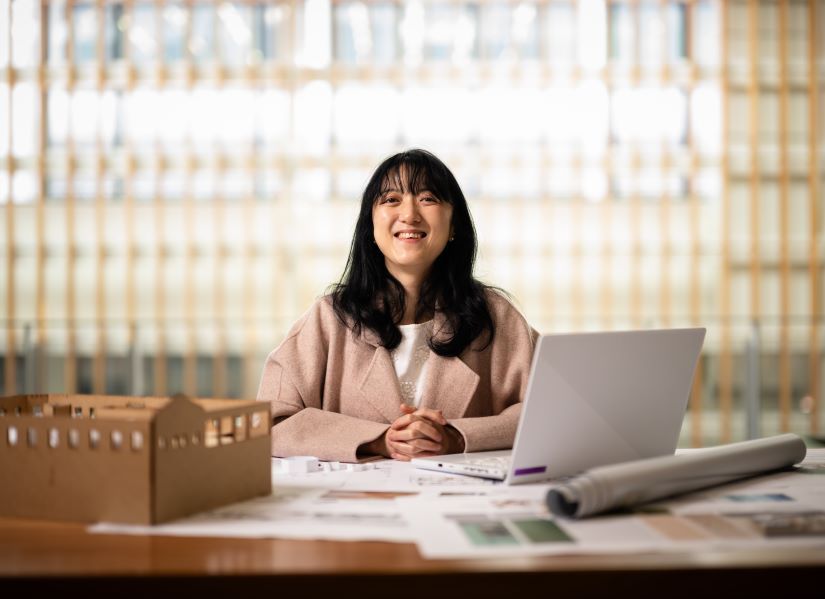
30 July, 2024
My pathway to QUT
Driven by my passion for interior design and home furnishing, I embarked on my professional journey with IKEA following my graduation in Shanghai, China in 2007. Over 14 years, I worked in diverse roles such as interior designer, visual merchandiser and project leader, honing my skills in interior design and range presentation, as well as gaining expertise in collaboration and project management. This enriching experience solidified my resolve to pursue a career as an interior designer, so I decided to further my education in interior architecture at QUT.
QUT stood out as a real-world university renowned for its practical approach to education, emphasising hands-on learning, project-based assignments, industry-oriented projects and work placements. With a commitment to nurturing students’ practical abilities to tackle real-world challenges, QUT’s architecture and built environment programs hold a prestigious position, ranking among the top 100 universities in the QS World Ranking by Subject 2024.
What ‘real-world’ learning looks like in interior design
‘Real world’ situations encapsulate scenarios or problems that reflect actual challenges people encounter. It involves the application of theoretical knowledge or concepts to practical contexts, thereby enhancing learning outcomes through a deeper understanding of their real-world applicability. In my course, this approach is exemplified through several key aspects:
Hands-on learning: Our curriculum integrates hands-on experiences such as experiments, case studies, projects, field trips, guest lectures, and industry professional critiques. These activities actively engage us with the subject matter.
Problem-based learning: We are presented with authentic challenges or real-world problems and tasked with devising solutions. This approach stimulates our critical thinking, encourages cross-disciplinary collaboration, and underscores the relevance of theoretical knowledge in addressing practical issues.
Project-based assessments: Our assessments revolve around project-based tasks that require thorough research, strategic planning and execution aligned with the unit content. These projects serve as tangible demonstrations of our understanding and ability to apply acquired knowledge effectively.
Work placements: Integral to our learning experience are work placements, offering opportunities to gain hands-on experience in our field of study. Engaging in professional settings allow us to apply theoretical learning in real-world scenarios, acquiring valuable skills and insights that complement classroom teachings.
My favourite part of the course
My favourite part of the course is undoubtedly the capstone unit, ‘Interior Studio’, a curriculum of three years of progressive learning. This unit has been instrumental in furnishing me with crucial design skills necessary for my journey as an interior designer, by immersing me in the intricacies of the design process and methodologies. It provides a platform to apply theoretical knowledge into practical applications through project-based assignments, thereby enhancing my design thinking and nurturing my design aspirations. Moreover, the dynamic studio environment fosters collaborative learning, which has broadened my perspective and instilled in me a more holistic and innovative approach to problem-solving.
Support through my studies
Through the university’s student website, guidance from unit coordinators, and recommendations from my subject coordinator, I discovered various support services available both online and offline.
During my third semester, I faced the challenge to balance my study with my personal responsibilities. On the advice of my subject coordinator, I sought assistance from the university’s counselling service. The counselling session proved invaluable, providing a much-needed outlet to express my anxieties and concerns in a safe and supportive environment facilitated by a professional counsellor. Furthermore, the service offered practical solutions, including the extension of assessment deadlines, thereby affording me the necessary time to prioritise my other responsibilities without compromising the completion of my assessments.
Student life beyond the classroom
Primarily through my participation in on-campus classes and collaborative group projects, I’ve had the pleasure of meeting diverse individuals and establishing meaningful friendships. Beyond the confines of the classroom, I’ve engaged in extracurricular activities such as QUTAS (QUT Architecture Society) and GR-ID Society (QUT Interior Design Society). These platforms have provided me with opportunities to connect with like-minded students through a range of activities and workshops, while also creating valuable networking opportunities with industry professionals.
Queensland, the state in which QUT is located, boasts a diverse and breathtaking natural landscape. From picturesque national parks to hundreds of kilometres of pristine beaches, including the renowned Gold Coast and Sunshine Coast, as well as lush tropical rainforests and the iconic Great Barrier Reef, Queensland offers a plethora of natural wonders to explore. As a nature enthusiast, Brisbane's status as a gateway to Queensland makes it the perfect place for my studies, allowing me to immerse myself in both academic pursuits and the splendour of nature.
Study our Bachelor of Built Environment (Honours) (Interior Design) like Xin